Twenty-Five Years of Geomorphological Evolution in the Gokurakudani Gully (Unzen Volcano): Topography, Subsurface Geophysics and Sediment Analysis
Abstract
:1. Introduction and State of the Art
1.1. Syn-Eruptive to Decadal-Scale Erosion on Volcanoes
1.2. Quaternary-Scale Erosion Rates on Volcanoes
1.3. Lahar: The Major Observed—Agent of Change
1.4. From Pyroclastic Density Currents’ Deposits to Lahar Deposits
1.5. Topographic and Geological Setting
1.6. The Unzen Volcano and the 1990–1995 Eruption
2. Methodology
- (1)
- fieldwork,
- (2)
- laboratory analysis of the samples and collected empirical data and,
- (3)
- geophysical exploration based on ground penetrating radar (GPR).
2.1. Imagery and Topographic Data
2.1.1. Data Acquisition
2.1.2. UAV Data Processing
2.1.3. GIS Analysis
2.2. Characterization of the Gully Floor and the Walls’ Material
Dry Sieving and Grain Size Analysis
2.3. Subsurface Geophysical Data Using Ground Penetrating Radar (GPR)
2.3.1. The GPR Method
2.3.2. Field Data Acquisition with the Mala-ProEx GPR
2.3.3. GPR Data Processing
- -
- Static time correction to remove the signal time before entry into the ground;
- -
- DEWOW filtering (low-cut filter) to remove the air-ground reflection (this step was removed from one of the transects as it was erasing some of the data associated with the removed signal);
- -
- AGC gain amplification with a 40 ns window and a 1.12 multiplier;
- -
- Removal of the background noise with an average moving window every 100 traces;
- -
- Energy propagation loss compensation using an energy decay multiplier of 1.44;
- -
- Measure of the velocity through the ground. As the common mid-point method is not possible with the shielded antenna [42], the authors used the slopes of the hyperbola curves to calculate the velocity profiles;
- -
- Finally, the velocities are then converted into depths using the calculated velocities. Because the data were acquired on semi-horizontal surfaces, no topographic data migration was necessary.
3. Results and Interpretations
3.1. Planform Changes of the Gokurakudani Gully
3.2. Vertical Changes of the Gokurakudani Gully
3.3. Cross Section Areas’ Evolution from 2005 to 2016
3.4. Topographic Results’ Interpretation
3.5. The Material: Grain Size Analysis and Material Differentiation
3.6. The Subsurface Structure of the Gully Floor from GPR
4. Discussion
4.1. Topographic Change over Time
4.2. Grain Size of Different Features in the Gully
4.3. Subsurface Structure: Multiple Processes
5. Conclusions
- (1)
- The left and right walls of the Gokurakudani gully evolve at different rates and that the collapsed profiles and maximum sustained slope angles vary by more than 20 degrees. This difference corresponds to layers in the pyroclastic density current deposits either tilting towards the gully or away from it.
- (2)
- The longitudinal profile is overall close to an equilibrium profile, but there is an alternation of stable and of erosive and deposit-dominated zones. These patterns have appeared over time, when the erosion of the material from the last eruption let pre-eruptive rocks emerge.
- (3)
- Underneath the surface, the ground penetrating radar confirmed the fact that the gully is undergoing periods of erosion and eventually deposition in the same location. Underneath the present valley floor, there is evidence of gully wall collapses in the valley, which were then filled up. Even if the gully has been eroded during the last 20 years following the eruption, it however does not mean that it is a purely erosive process. Episodes of deposition also occurred. Methodologically, this has implications on the representativity of two sets of LiDAR data taken over time and compared against one another. Any erosion rate calculated from such datasets would not represent the full extent of erosion, and it might be necessary to complete the topographic data with subsurface geophysical investigation.
- (4)
- On top of the spatial variability (vertical and horizontal), there is a temporal variability in the material as well. Indeed, as the pyroclastic density current deposits are oozing the fine fraction out, and so without changing the surface topography, it means that (1) over time, there is less fine material available in the gully (notably to trigger lahars) and (2) “precise” grain-size analysis, which is often a pillar in geomorphology or sedimentology, is not a reliable parameter. In other words, the same pyroclastic density current may have a very different grain size distribution at an outcrop, depending on the time at which scientists go and sample it. Even if the deposit does not show any sign of erosion, in the case of unconsolidated coarse and mixed grain deposits, outcrop analysis cannot be performed as scientists would do for fluviatile or estuary data for instance.
Author Contributions
Funding
Institutional Review Board Statement
Informed Consent Statement
Data Availability Statement
Conflicts of Interest
References
- Gilbert, G.K. The convexity of hilltops. J. Geol. 1909, 17, 344–350. [Google Scholar] [CrossRef] [Green Version]
- Roering, J.J. How well can hillslope evolution models “explain topography? Simulating soil transport and production with high-resolution topographic data. GSA Bull. 2008, 120, 1248–1262. [Google Scholar] [CrossRef]
- Lavigne, F.; Thouret, J.-C. Lahars at Merapi Volcano, Central Java: An Overview. J. Volcanol. Geotherm. Res. 2000, 100, 423–456. [Google Scholar] [CrossRef]
- Tsunetaka, H.; Shinohara, H.; Hotta, N.; Gomez, C.; Sakai, Y. Multi-decadal changes in the relationships between rainfall characteristics and debris-flow occurrences in response to gully evolution after the 1990–1995 Mount Unzen eruptions. Earth Surf. Process. 2021, 46, 2141–2162. [Google Scholar] [CrossRef]
- Hadmoko, D.S.; de Belizal, E.; Mutaqin, B.W.; Dipayana, G.A.; MArfai, M.A.; Lavigne, F.; Sartohadi, J.; Worosuprojo, S.; Starheim, C.A.; Gomez, C. Post-eruptive lahars at Kali Putih following the 2010 eruption of Merapi volcano, Indoensia: Occurrences and impacts. Nat. Hazards 2018, 94, 419–444. [Google Scholar] [CrossRef]
- Thierry, P.; Jousset, P.; Boichu, M.; Surono, B.F.; Bignami, C.; Lavigne, F.; Picquout, A.; Le Cozanet, G.; Jenkins, S.; Berger, J.; et al. Merapi Volcano 2010 Crisis: A Case Study for Implementing the FP7 MIAVITA European Project; Geoscience Union General Assembly: Vienna, Austria, 2011. [Google Scholar]
- De Belizal, E.; Lavigne, F.; Hadmoko, D.S.; Degeai, J.-P.; Dipayana, G.A.; Mutaqin, B.W.; Marfai, M.A.; Coquet, M.; Le Mauff, B.; Robin, A.-K.; et al. Rain-triggered lahars following the 2010 eruption of Merapi volcano, Indonesia: A major risk. J. Volcanol. Geotherm. Res. 2013, 261, 330–347. [Google Scholar] [CrossRef]
- Scott, W.E.; Hoblitt, R.P.; Torres, R.C.; Slef, S.; Martinez, M.M.L.; Nillos, T. Pyroclastic Flows of the 15 June 1991 Claimactic Eruption of Mt. Pinatubo. In Fire and Mud, Eruptions and Lahars of Mt. Pinatubo, Phillipines; Newhall, C.G., Punongbayan, R.S., Eds.; University of Washington Press: Washington, DC, USA, 1996; pp. 545–570. [Google Scholar]
- Van Westen, C.J.; Daag, A.S. Analysing the relation between rainfall characteristics and lahar activity at Mount Pinatubo, Philippines. Earth Surf. Process. 2005, 30, 1663–1674. [Google Scholar] [CrossRef]
- Dinehart, R.L. Sediment Transport at Gaging Stations near Mt. St Helens, Washington, 1980–1990, Data Collection and Analysis; US Geological Survey: Denver, CO, USA, 1998; Volume 1573, 111p.
- Gonda, Y.; Miyata, S.; Fujita, M.; Legono, D.; Tsutsumi, D. Temporal Changes in Runoff Characteristics of Lahars After the 1984 Eruption of Mt. Merapi, Indonesia. J. Disaster Res. 2019, 14, 61–68. [Google Scholar] [CrossRef]
- Major, J.J.; Pierson, T.C.; Dinehart, R.L.; Costa, J.E. Sediment yield following severe volcanic disturbance—A two-decade perspective from Mount St Helens. Geology 2000, 28, 819–822. [Google Scholar] [CrossRef]
- Suwa, H.; Okuda, S. Deposition of debris flows on a fan surface, Mt. Yakedake, Japan. Z Geomorphol. Sup. 1983, 46, 79–101. [Google Scholar]
- Lavigne, F.; Suwa, H. Contrasts between debris-flows, hyperconcentrated flows and stream flows at a channel of Mount Semeru, East Java, Indonesia. Geomorphology 2004, 61, 41–58. [Google Scholar] [CrossRef]
- Puyraveau, R.-A.; Rad, S.; Basile-Doelsch, I.; Deparis, J.; Jaouen, T.; Nehlig, P. Mayotte Critical Zone Observatory: Preliminary Results on Chemical Weathering and Erosion Rates on Volcanic Edifices. Procedia Earth Planet. Sci. 2014, 10, 73–76. [Google Scholar] [CrossRef]
- Bablon, M.; Quidelleur, X.; Samaniego, P.; Le Pennec, J.-L.; Lahitte, P.; Liorzou, C.; Bustillos, J.E.; Hidalgo, S. Eruptive chronology of Tungurahua volcano (Ecuador) revisited based on new K/Ar ages and geomorphological reconstructions. J. Volcanol. Geotherm. Res. 2018, 357, 378–398. [Google Scholar] [CrossRef]
- Samaniego, P.; Martin, H.; Monzier, M.; Robin, C.; Fornari, M.; Eissen, J.-P.; Cotton, J. Temporal evolution of magmatism in the Northern Volcanic Zone of the Andes: The geology and petrology of Cayambe Volcanic Complex (Ecuador). J. Petrol. 2005, 46, 2225–2252. [Google Scholar] [CrossRef] [Green Version]
- Hayakawa, Y.S.; Yokoyama, S.; Matsukura, Y. Erosion rates of waterfalls in post-volcanic fluvial systems around Aso volcano, southwestern Japan. Earth Surf. Process. 2008, 33, 801–812. [Google Scholar] [CrossRef]
- Hayakawa, Y.S.; Obanawa, H.; Matsukura, Y. Post-volcanic erosion rates of Shomyo falls in Tateyama, Central Japan. Geogr. Ann. A 2007, 90, 65–74. [Google Scholar] [CrossRef]
- Fontes, J.C.; Pereira, L.S.; Smith, R.E. Runoff and erosion in volcanic soils of Azores: Simulation with OPUS. Catena 2004, 56, 199–212. [Google Scholar] [CrossRef]
- Escher, B.G. On the Hot ‘Lahar’ (Mud Flow) of the Valley of the Ten Thousand Smokes (Alaska); van Wetenschappen, K.A., Ed.; Koninklijke Akademie van Wetenschappen: Amsterdam, The Netherlands, 1922; Volume 24, pp. 282–293. [Google Scholar]
- Pierson, T.C. Flow characteristics of large eruption-triggered debris flows at snow-clad volcanoes: Constraints for debris-flow models. J. Volcanol. Geotherm. Res. 1995, 66, 283–294. [Google Scholar] [CrossRef]
- Smith, G.A.; Fritz, W.J. Volcanic influences on terrestrial sedimentation. Geology 1989, 17, 375–376. [Google Scholar] [CrossRef]
- Vallance, J.W. Lahars. In Encyclopedia of Volcanoes; Sigurdsson, H., Houghton, B., McNutt, S.R., Rymer, H., Stix, J., Eds.; San Diego Academic Press: San Diego, CA, USA, 2000; pp. 601–616. [Google Scholar]
- Starheim, C.; Gomez, C.; Davies, T.; Lavigne, F.; Wassmer, P. In-flow evolution of lahar deposits from video-imagery with implications for post-event deposit interpretation, Mount Semeru, Indonesia. J. Volcanol. Geotherm. Res. 2013, 256, 96–104. [Google Scholar] [CrossRef]
- Scott, K.M. Origins, Behavior, and Sedimentology of Lahars and Lahar-Runout Flows in the Toutle Cowlitz River System; US Geological Survey: Reston, VA, USA, 1988; Volume 1447-A, 83p.
- Vallance, J.W.; Iverson, R.M. Chapter 37—Lahars and Their Deposits. In Encyclopedia of Volcanoes, 2nd ed.; Sigurdsson, H., Ed.; Academic Press: Cambridge, MA, USA, 2015; Volume 649, p. 664. [Google Scholar]
- Smith, G.A.; Lowe, D.R. Lahars: Volcano-hydrologic events and deposition in the debris flow-hyperconcentrated flow continuum. In Sedimentation in Volcanic Setting; Fisher, R.V., Smiths, G.A., Eds.; SEPM Special Publication: Tulsa, OK, USA, 1991; Volume 45, pp. 59–70. [Google Scholar]
- Pierson, T.C.; Costa, J.E. A rheologic classification of subaerial sediment-water flow. Geol. Soc. Am. Rev. Eng. Geol. 1987, 7, 1–12. [Google Scholar]
- Pierson, T.C.; Scott, K.M. Downstream dilution of a lahar, transition from debris flow to hyperconcentrated streamflow. Water Resour. Res. 1985, 21, 1511–1524. [Google Scholar] [CrossRef]
- Gomez, C.; Lavigne, F. Transverse architecture of lahar terraces, inferred from radargrams: Preliminary results from Semeru Volcano, Indonesia. Earth Surf. Process. 2010, 35, 1116–1121. [Google Scholar] [CrossRef]
- Lavigne, F.; Thouret, J.-C. Les lahars, depots, occurrence et dynamique: Une revue des ecoulements volcano-hydrologiques. BSGF-EARTH SCI B 2000, 171, 545–558. (In French) [Google Scholar] [CrossRef]
- Arguden, A.T.; Rodolfo, K.S. Sedimentologic and dynamic differences between hot and cold laharic debris flows of Mayon Volcano, Philippines. GSA Bull. 1990, 102, 865–876. [Google Scholar] [CrossRef]
- Miyabuchi, Y. Deposits associated with the 1990–1995 eruption of Unzen volcano, Japan. J. Volcanol. Geotherm. Res. 1999, 89, 139–158. [Google Scholar] [CrossRef]
- Procter, J.N.; Cronin, S.J.; Zernack, A.V.; Lube, G.; Stewart, R.B.; Nemeth, K.; Keys, H. Debris flow evolution and the activation of an explosive hydrothermal system. J. Volcanol. Geotherm. Res. 2014, 286, 303–316. [Google Scholar] [CrossRef]
- Capra, L.; Borselli, L.; Varley, N.; Gavilanes-Ruiz, J.C.; Norini, G.; Sarocchi, D.; Caballero, L.; Cortes, A. Rainfall-triggered lahars at Volcan de Colima, Mexico: Surface hydro-repellency as initiation process. J. Volcanol. Geotherm. Res. 2010, 189, 105–117. [Google Scholar] [CrossRef]
- Vazquez, R.; Capra, L.; Coviello, V. Factors controlling erosion/deposition phenomena related to lahars at Volcan de Colima, Mexico. Nat. Hazards Earth Syst. Sci. 2016, 16, 1881–1895. [Google Scholar] [CrossRef] [Green Version]
- Gertisser, R.; Cassidy, N.J.; Charbonnier, S.J.; Nuzzo, L.; Preece, K. Overbank block-and-ash flow deposits and the impact of valley-derived, unconfined flows on populated areas at Merapi volcano, Java, Indonesia. Nat. Hazards 2012, 60, 623–648. [Google Scholar] [CrossRef]
- Gomez, C.; Lavigne, F.; Lespinasse, N.; Hadmoko, D.S.; Wassmer, P. Longitudinal structure of pyroclastic-flow deposits, revealed by GPR survey, at Merapi Volcano, Java, Indonesia. J. Volcanol. Geotherm. Res. 2008, 176, 439–447. [Google Scholar] [CrossRef]
- Gomez, C.; Lavigne, F.; Hadmoko, D.S.; Lespinasse, N.; Wassmer, P. Block-and-ash flow deposition: A conceptual model from a GPR survey on pyroclastic-flow deposits at Merapi Volcano, Indonesia. Geomorphology 2009, 110, 118–127. [Google Scholar] [CrossRef]
- Gomez, C.; Lavigne, F.; Hadmoko, S.D.; Wassmer, P. Insights into lahar deposition processes in the Curah Lengkong (Semeru Volcano, Indonesia) using photogrammetry-based geospatial analysis, near-surface geophysics and CFD modelling. J. Volcanol. Geotherm. Res. 2018, 353, 102–113. [Google Scholar] [CrossRef]
- Ettinger, S.; Manville, V.; Kruse, S.; Paris, R. GPR-derived architecture of a lahar-generated fan at Cotopaxi, Ecuador. Geomorphology 2014, 213, 225–239. [Google Scholar] [CrossRef]
- Watanabe, K.; Hoshizumi, H. Geological Map of Unzen Volcano. 1/25,000 Map; Geological Survey of Japan: Tsukuba, Japan, 1995.
- Nakada, S.; Shimizu, H.; Ohta, K. Overview of the 1990–1995 eruption at Unzen Volcano. J. Volcanol. Geotherm. Res. 1999, 89, 1–22. [Google Scholar] [CrossRef]
- Gomez, C.; Wassmer, P. Evolution of the Unzen Volcano and the Shimabara Peninsula (Japan) during the last 60 years: The role of the 1990–1995 eruption in modifying the landscape. Geomorphol. Relief Process. Environ. 2015, 21, 205–216. [Google Scholar] [CrossRef]
- Hirakawa, H.; Okano, K.; Ueno, T.; Tsutsumi, D.; Miyata, S.; Satofuka, Y. Topographical and geological characteristics of source areas of debris flows on hillslope coered with pyroclastic-flow deposits for 20 years after the eruption of Mt. Unzen. J. Jpn. Soc. Erosion. Control. Eng. 2018, 71, 12–20, (In Japanese with English Abstract). [Google Scholar]
- Gomez, C.; Hotta, N.; Shinohara, Y.; Sakai, Y.; Tsunetaka, H.; Yano, A.; Kitamoto, G.; Sakamoto, M. Understanding the Variations of Internal Sedimentary Structures and Material Characteristics using Ground Penetrating Radar. Jpn. Soc. Erosion. Control Eng. Annu. Meet. Proc. 2018, V-079, 209–210. [Google Scholar]
- Gomez, C.; Hotta, N.; Shinohara, Y.; Tsunetaka, H. Grain-size distribution change at Unzen volcano and impact on lahar triggering and flowage. Jpn. Soc. Eros. Control. Eng. Annu. Meet. Proc. 2019, TI-004, 17–18. [Google Scholar]
- Gomez, C. Digital photogrammetry and GIS-based analysis of the bio-geomorphological evolution of Sakurajima Volcano, diachronic analysis from 1947 to 2006. J. Volcanol. Geotherm. Res. 2014, 280, 1–13. [Google Scholar] [CrossRef]
- Gomez, C.; Hayakawa, Y.; Obanawa, H. A study of Japanese landscapes using structure from motion derived DSMs and DEMs based on historical aerial photographs: New opportunities for vegetation monitoring and diachronic geomorphology. Geomorphology 2015, 242, 11–20. [Google Scholar] [CrossRef] [Green Version]
- Westoby, M.J.; Brasington, J.; Glasser, N.F.; Hambrey, M.J.; Reynolds, J.M. ‘Structure-from-Motion’ photogrammetry: A low-cost, effective tool for geoscience application. Geomorphology 2012, 179, 300–314. [Google Scholar] [CrossRef] [Green Version]
- Folk, R.L. Petrology of Sedimentary Rocks; Hemphill’s Book Store: Austin, TX, USA, 1968; 170p. [Google Scholar]
- Jol, H.M. Ground Penetrating Radar: Theory and Applications; Elsevier Science Publishing: Amsterdam, The Netherlands, 2009; 508p. [Google Scholar]
- Scott, K.M.; Vallance, J.W.; Kerle, N.; Macias, J.-L.; Strauch, W.; Devoli, G. Catastrophic precipitation-triggered lahar at Casita volcano, Nicaragua: Occurrence, bulking and transformation. Earth Surf. Process. 2005, 30, 59–79. [Google Scholar] [CrossRef]
- Furuya, T. Geomorphology of Merapi volcano; Volcanic Sabo Technical Centre & Japan International Cooperation Agency, Sabo Tech. Centre Report: Yogyakarta, Indian, 1989; 24p.
- Vazquez, R.; Capra, L.; Caballero, L.; Arambula-Mendoza, R.; Reyes-Davila, G. The anatomy of a lahar: Deciphering the 15th September 2012 lahar at Volcan de Colima, Mexico. J. Volcanol. Geotherm. Res. 2014, 272, 126–136. [Google Scholar] [CrossRef]
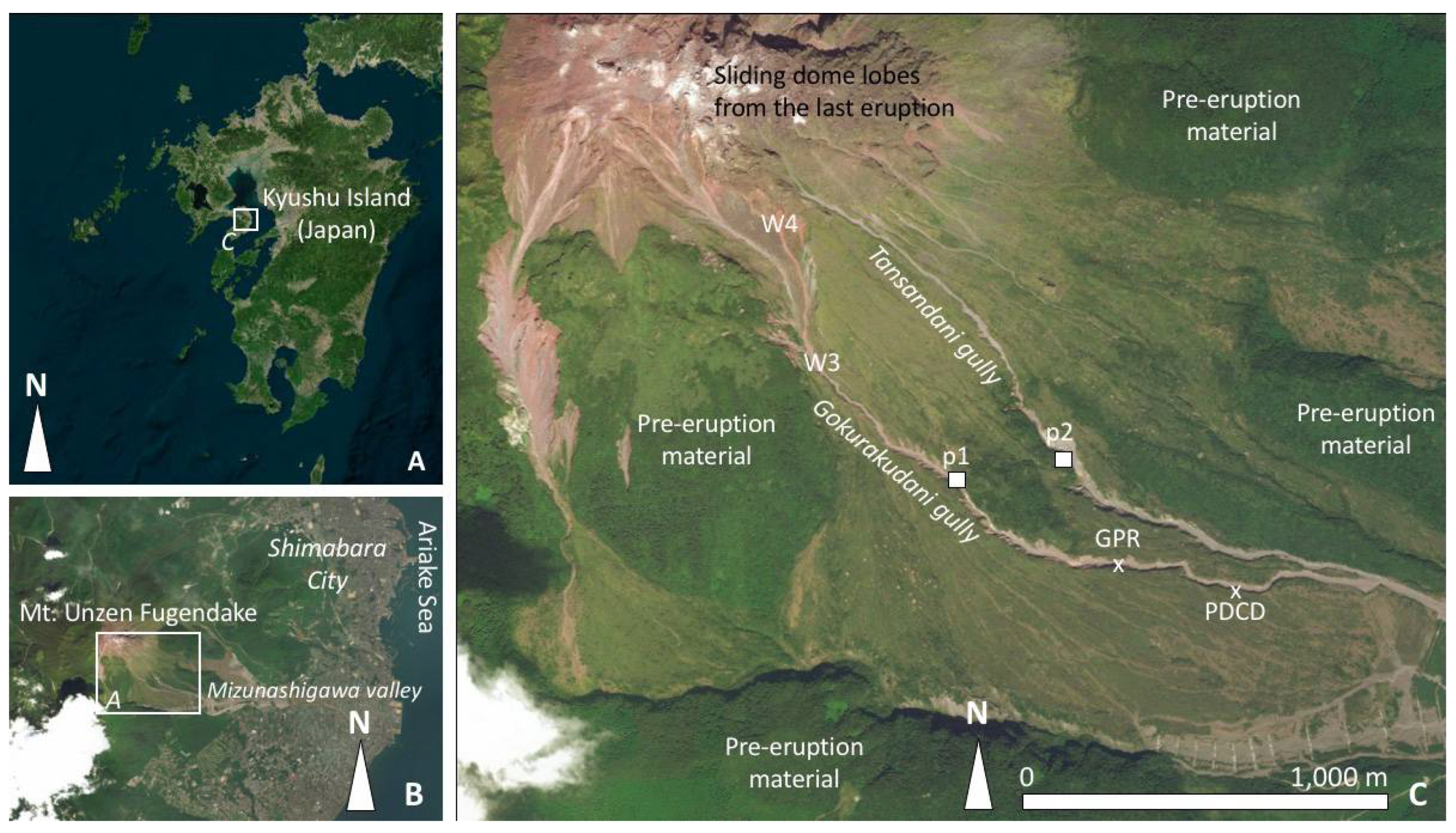
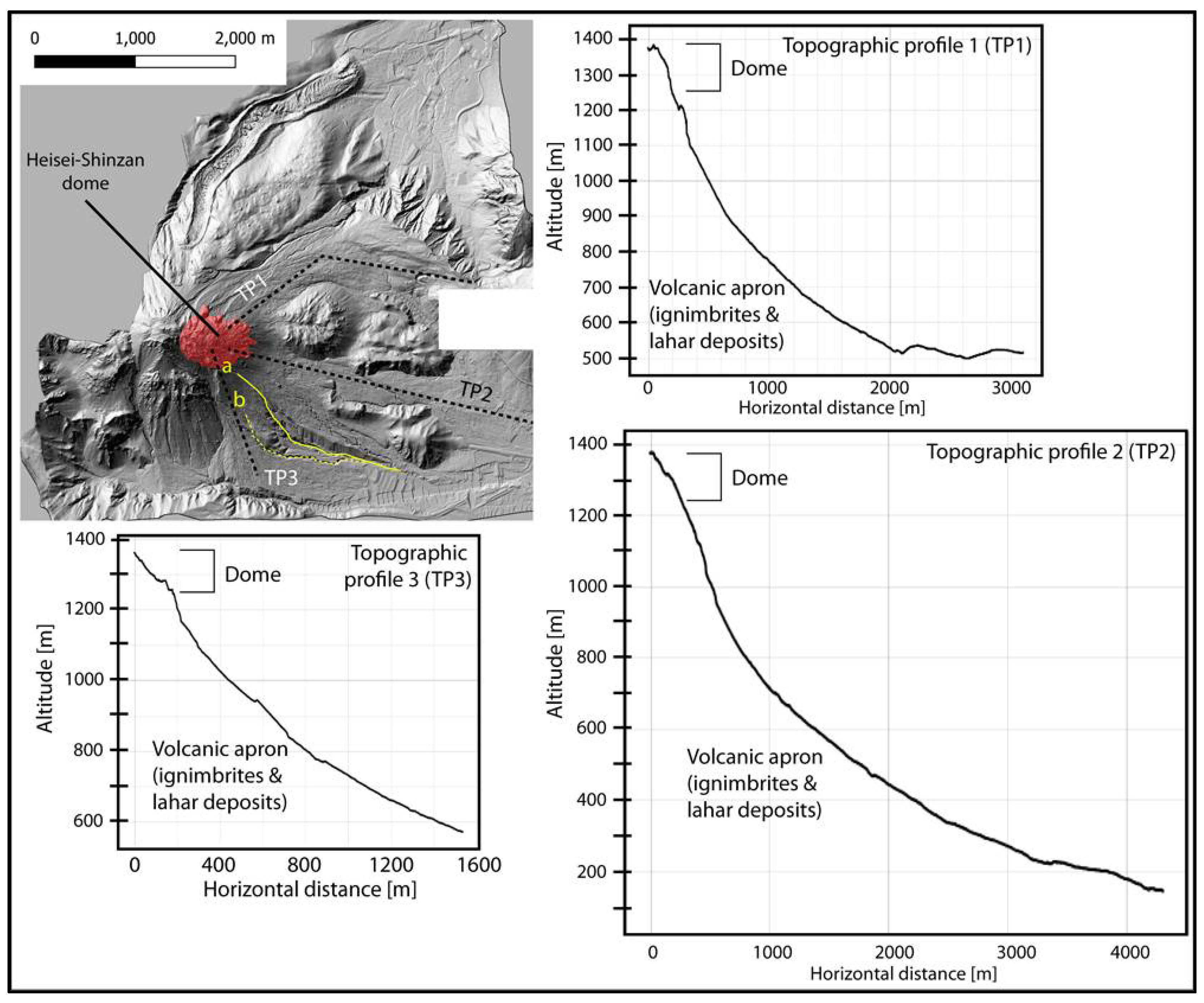
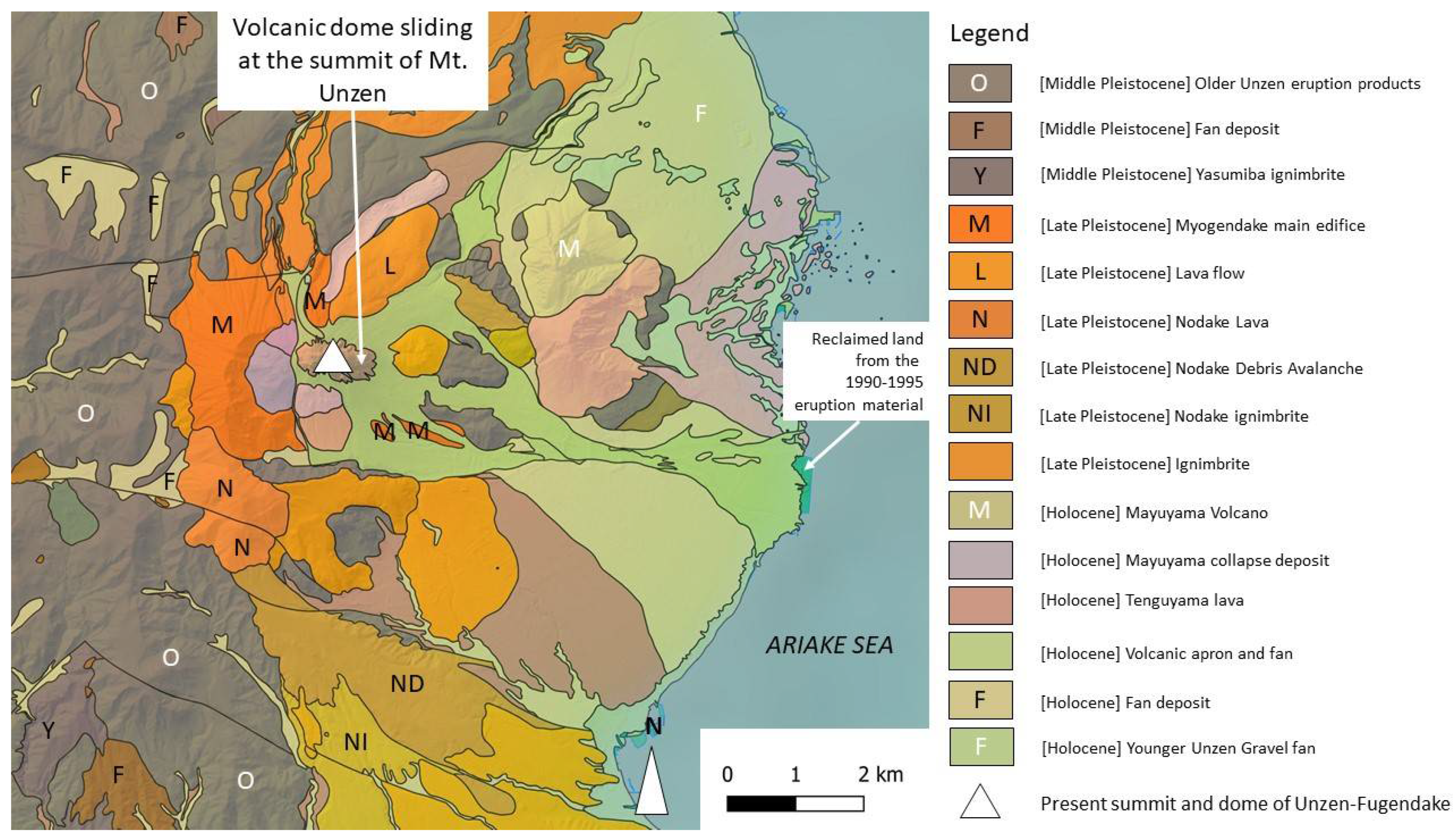
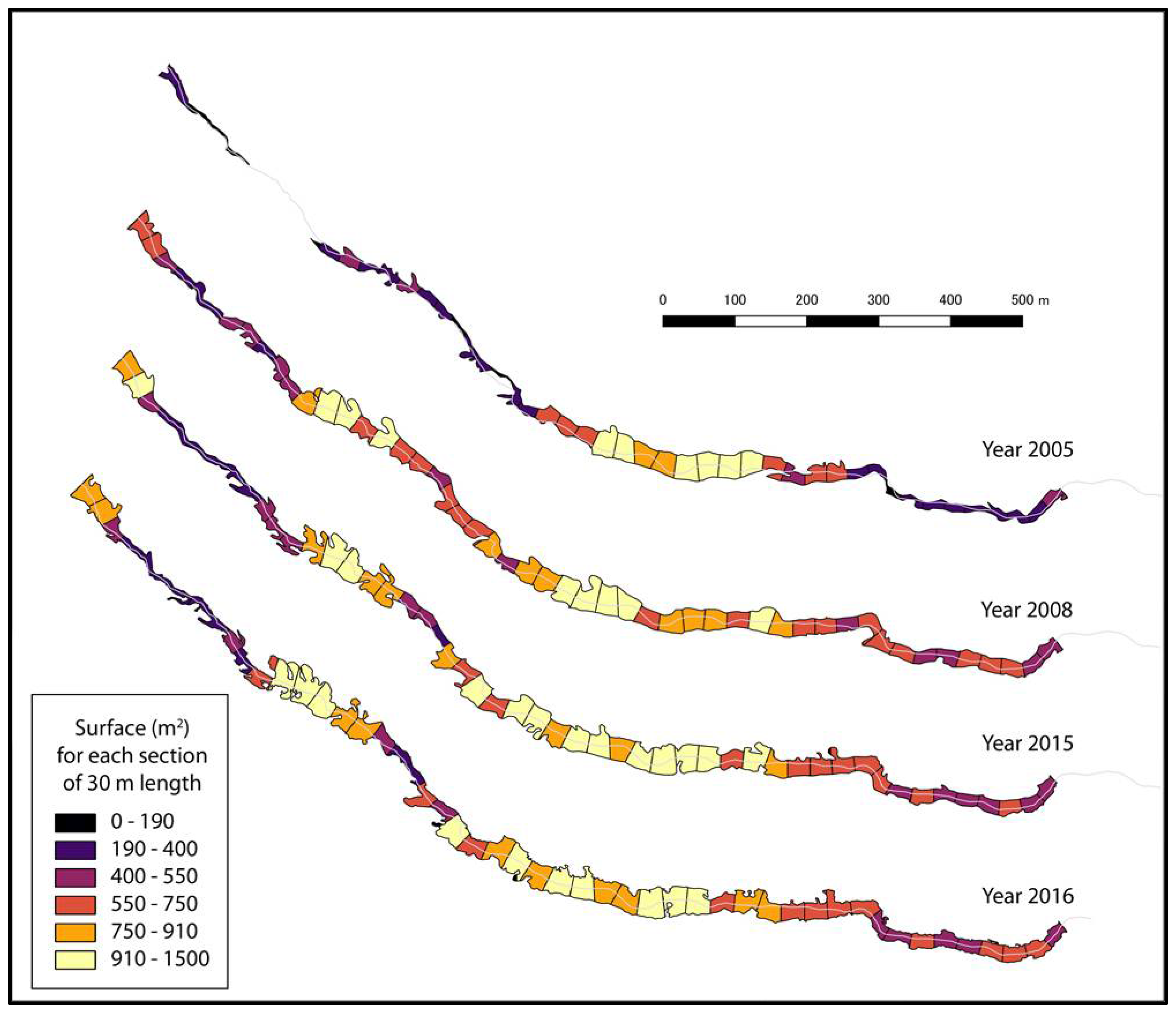
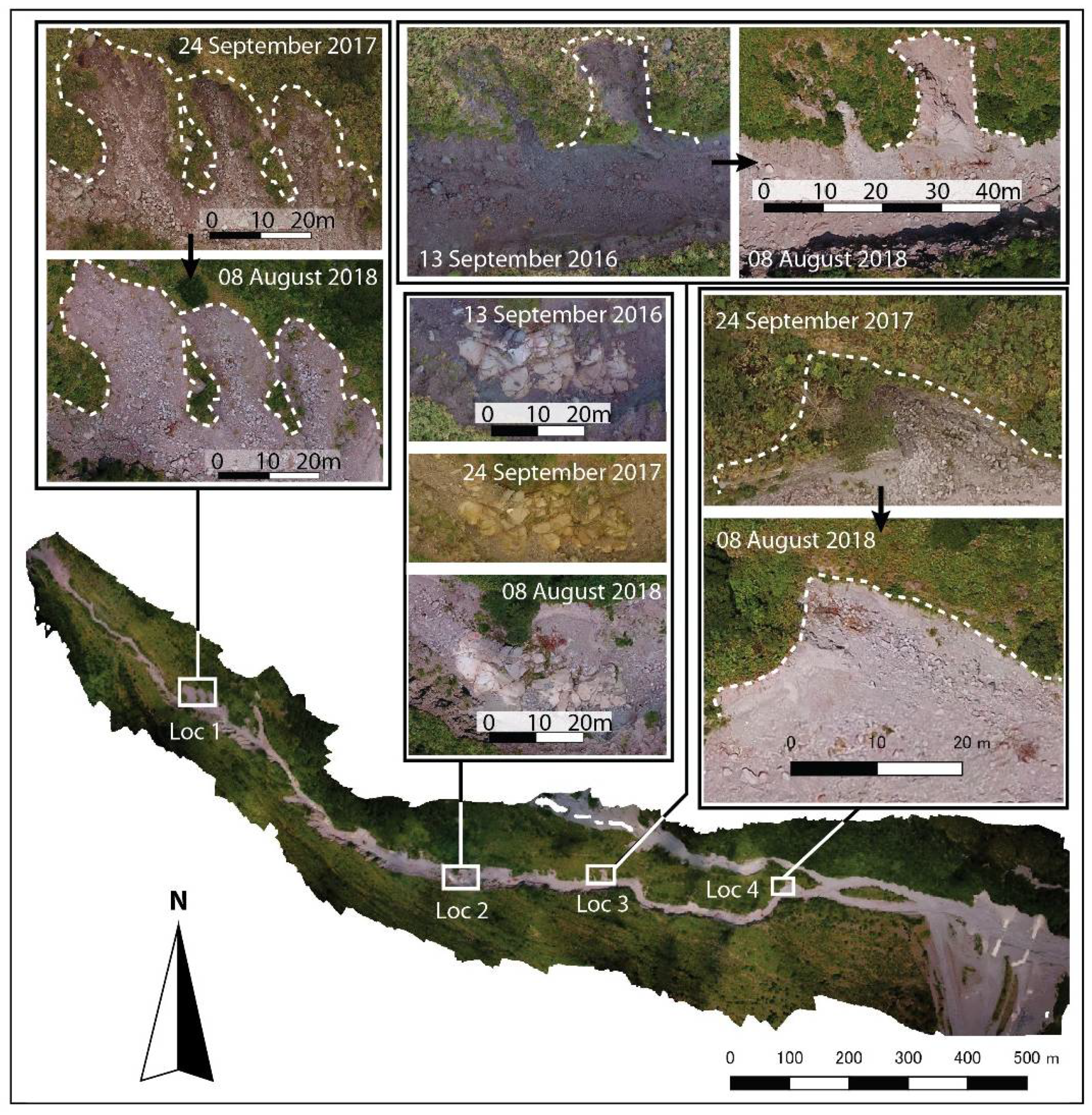
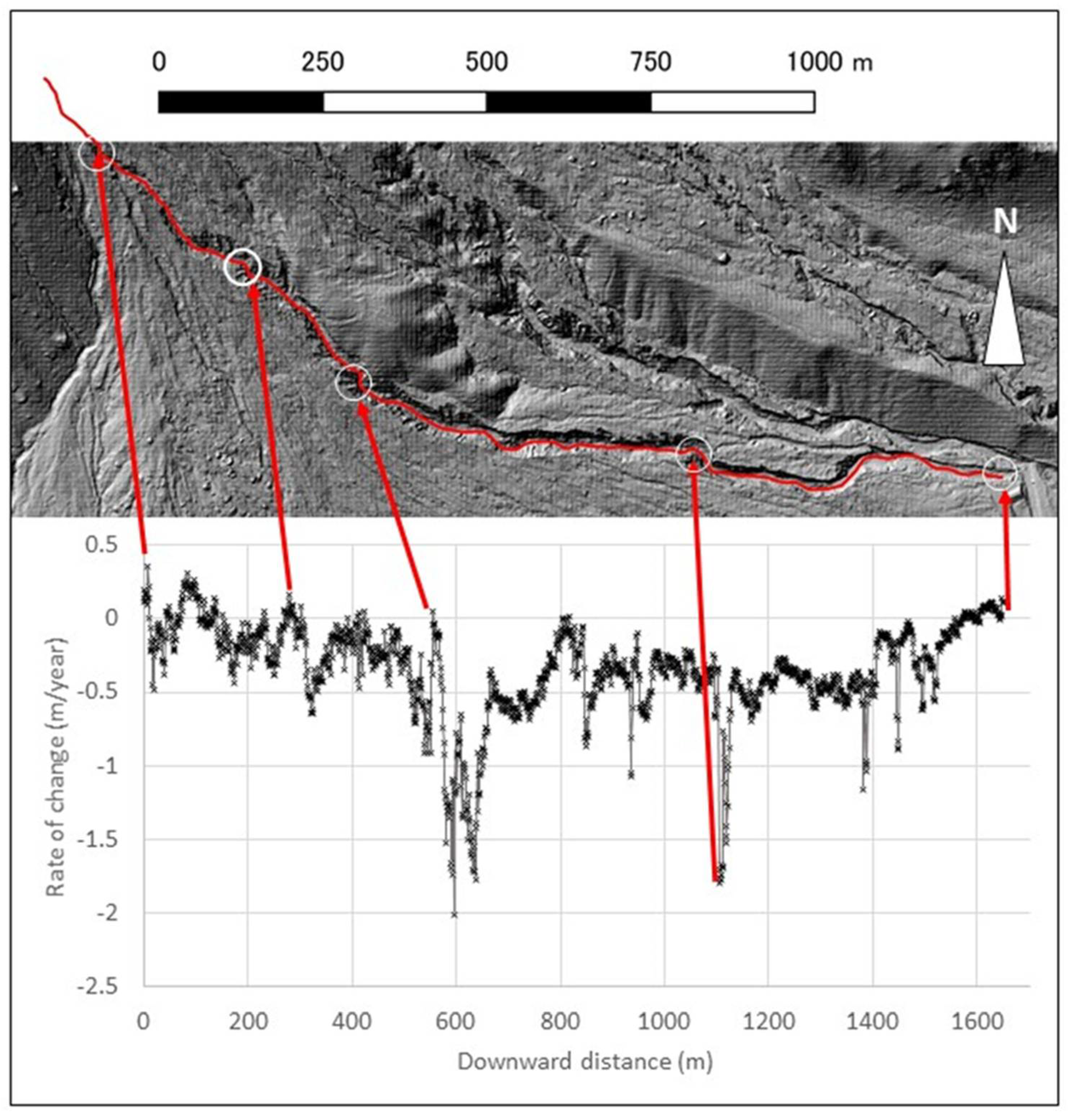
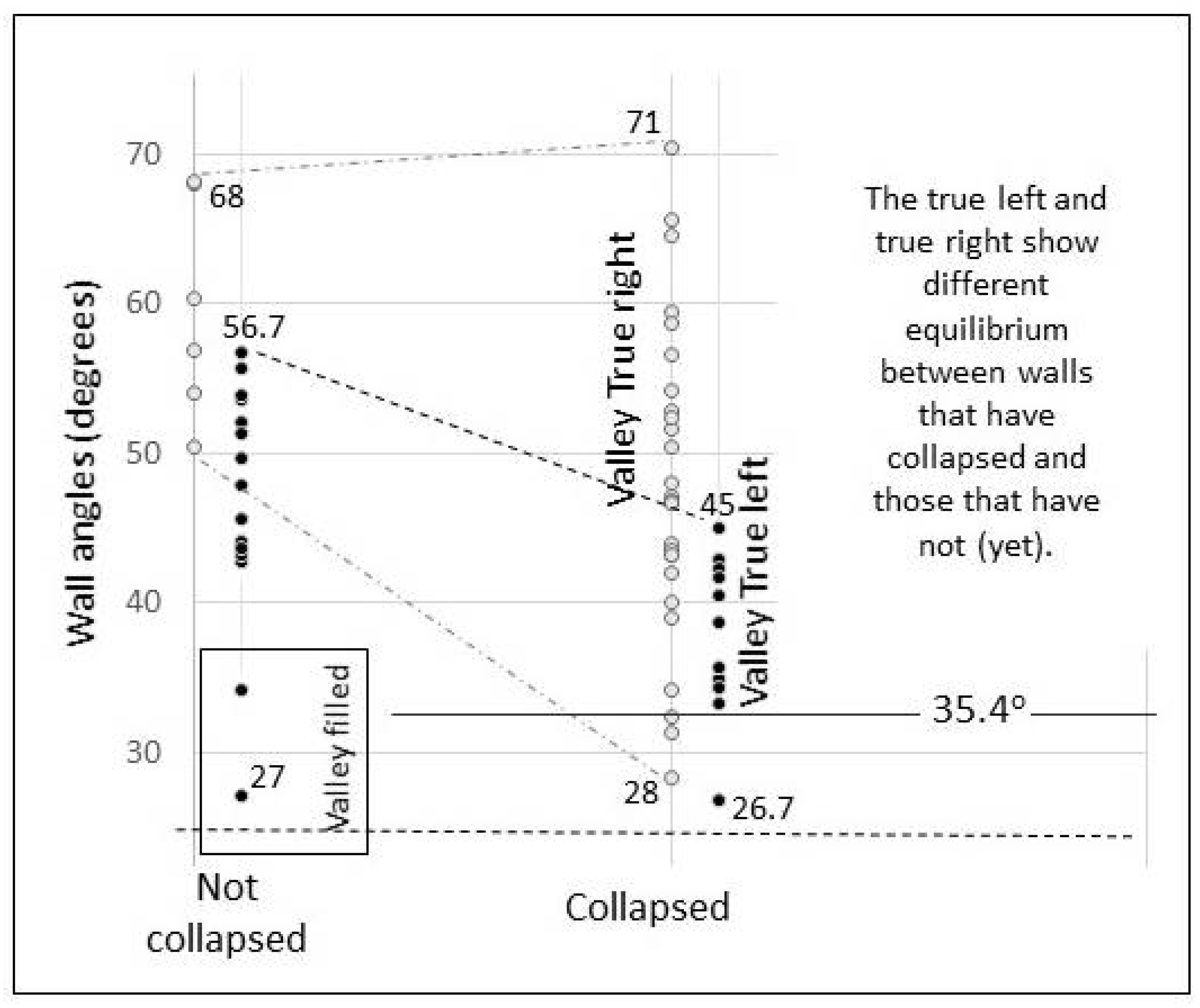
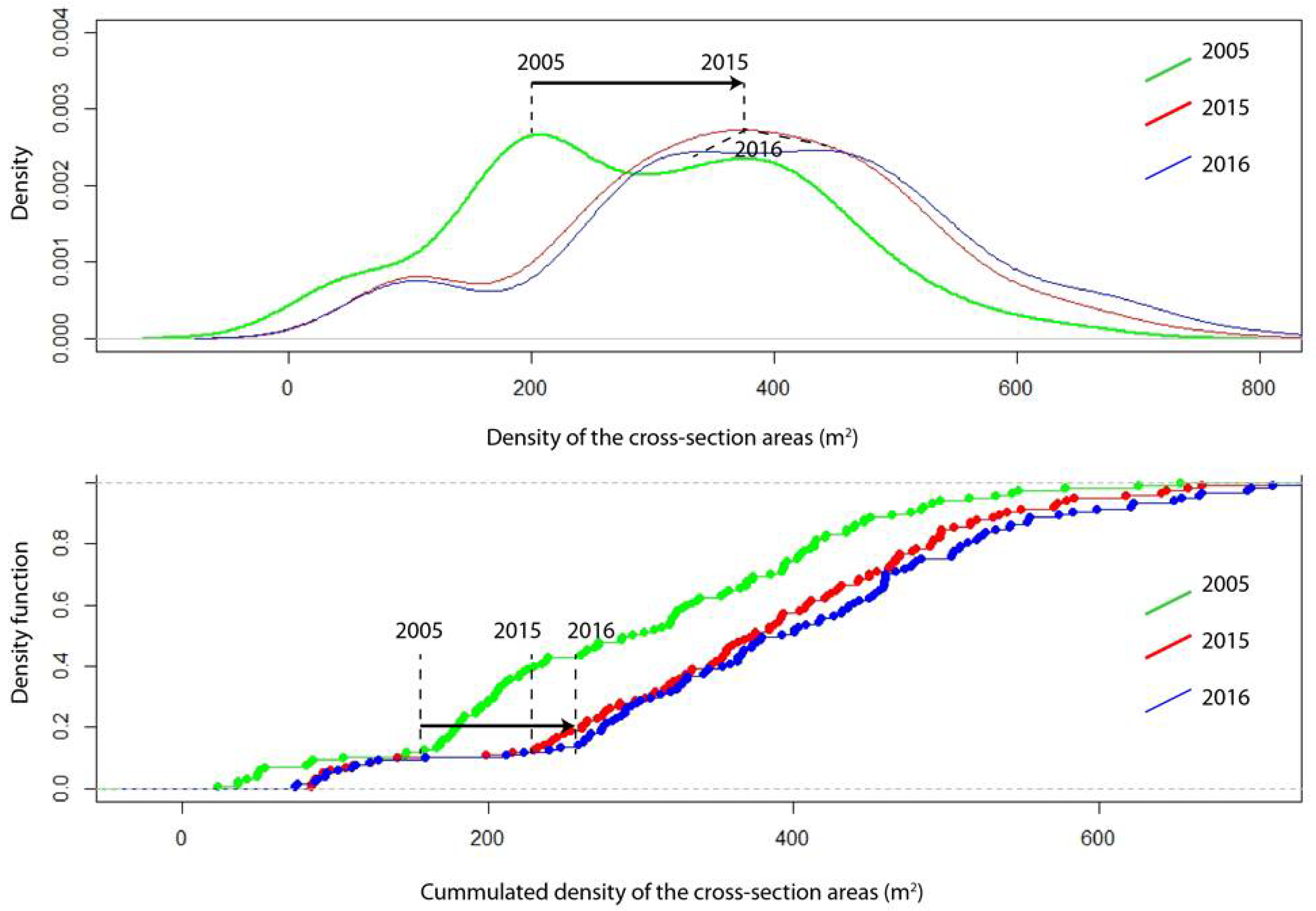
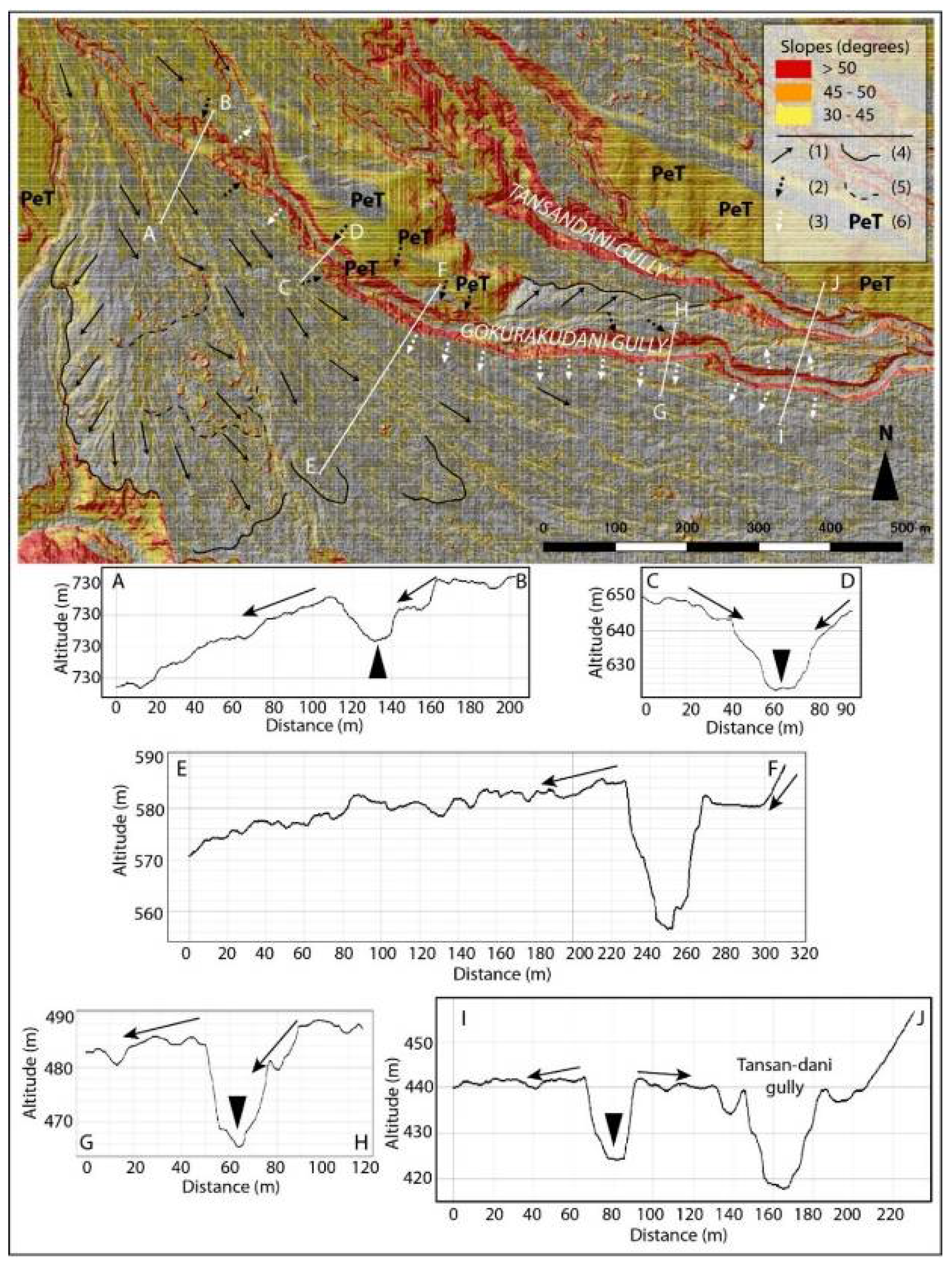
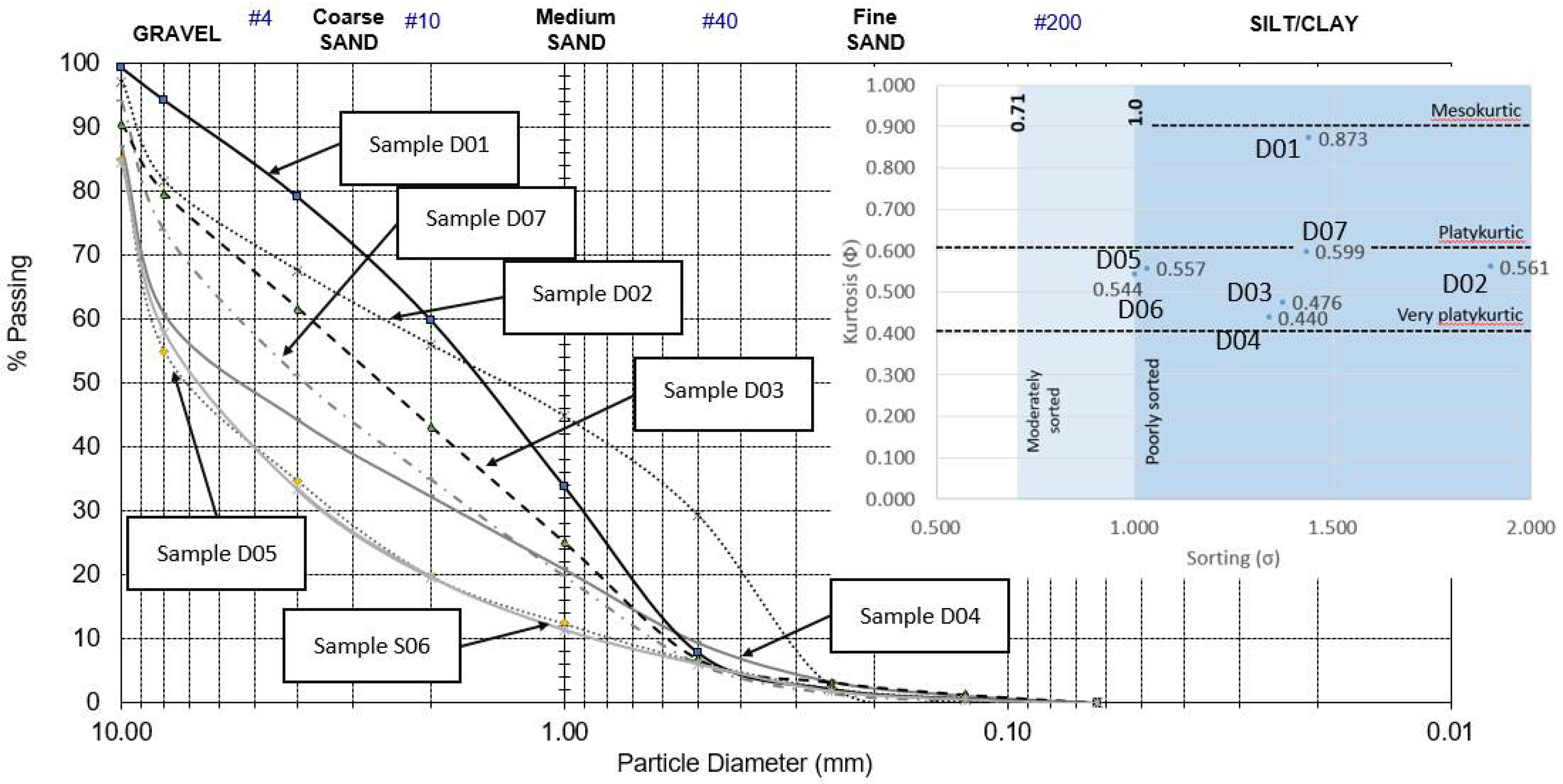
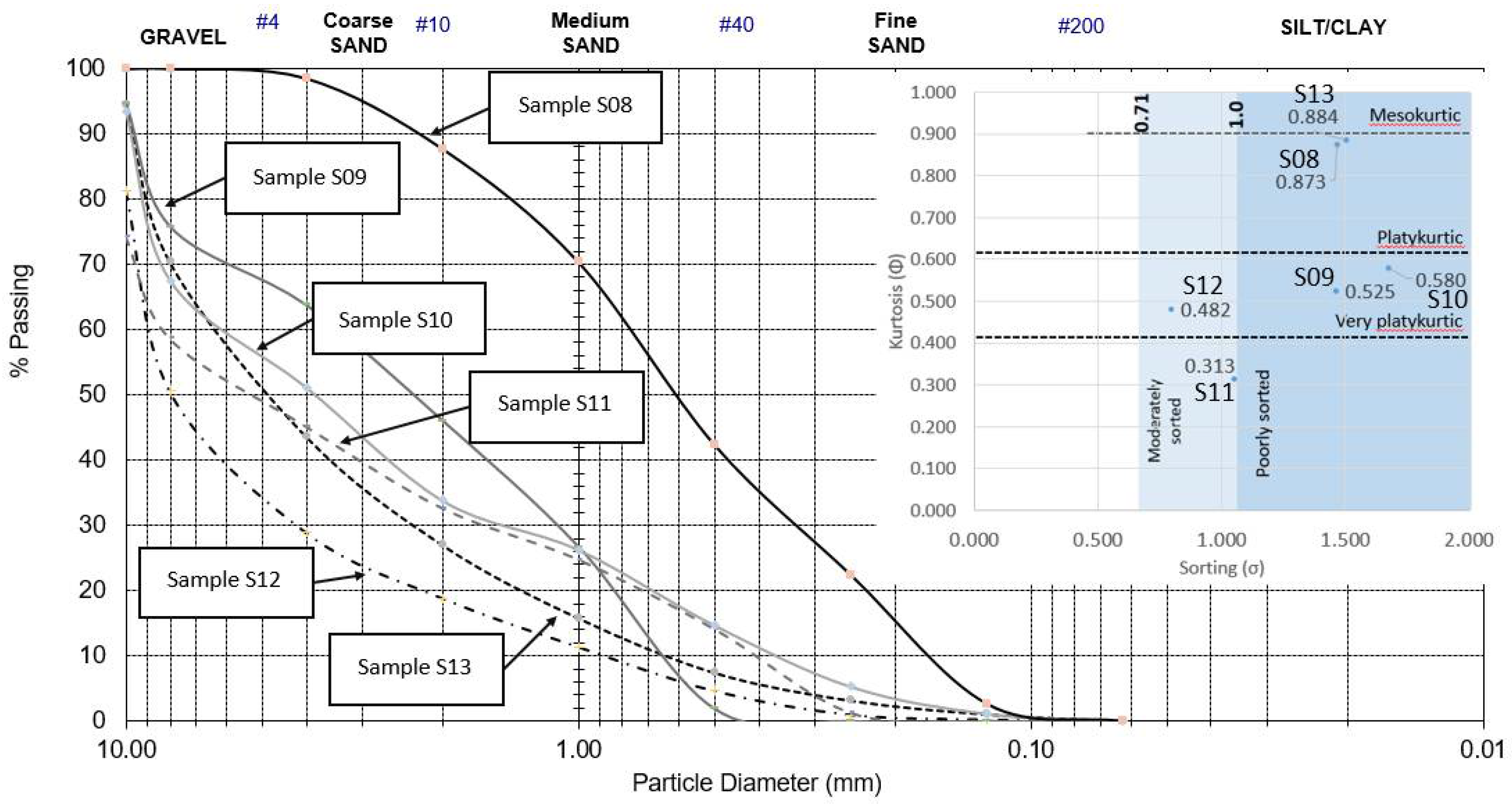
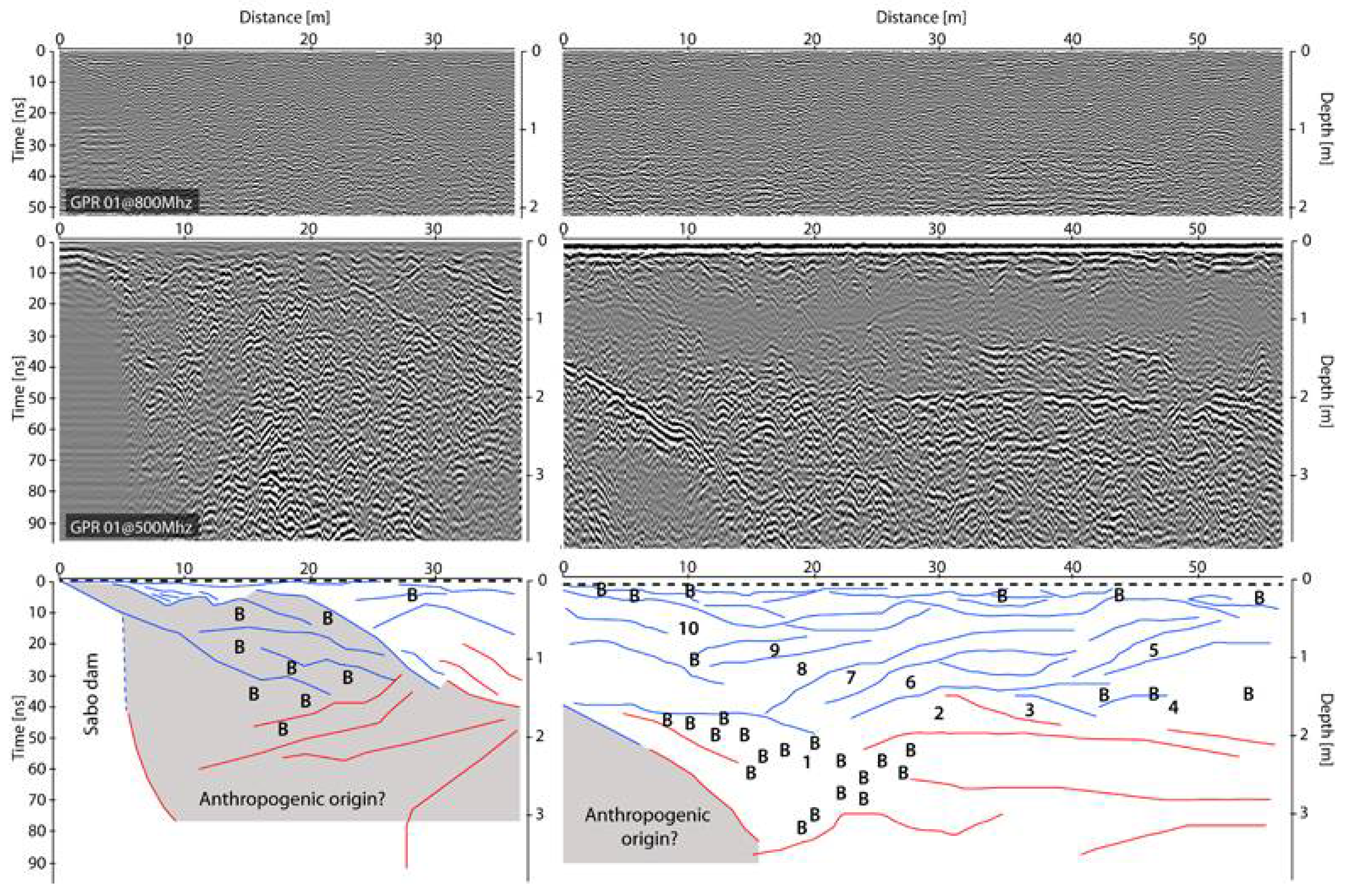
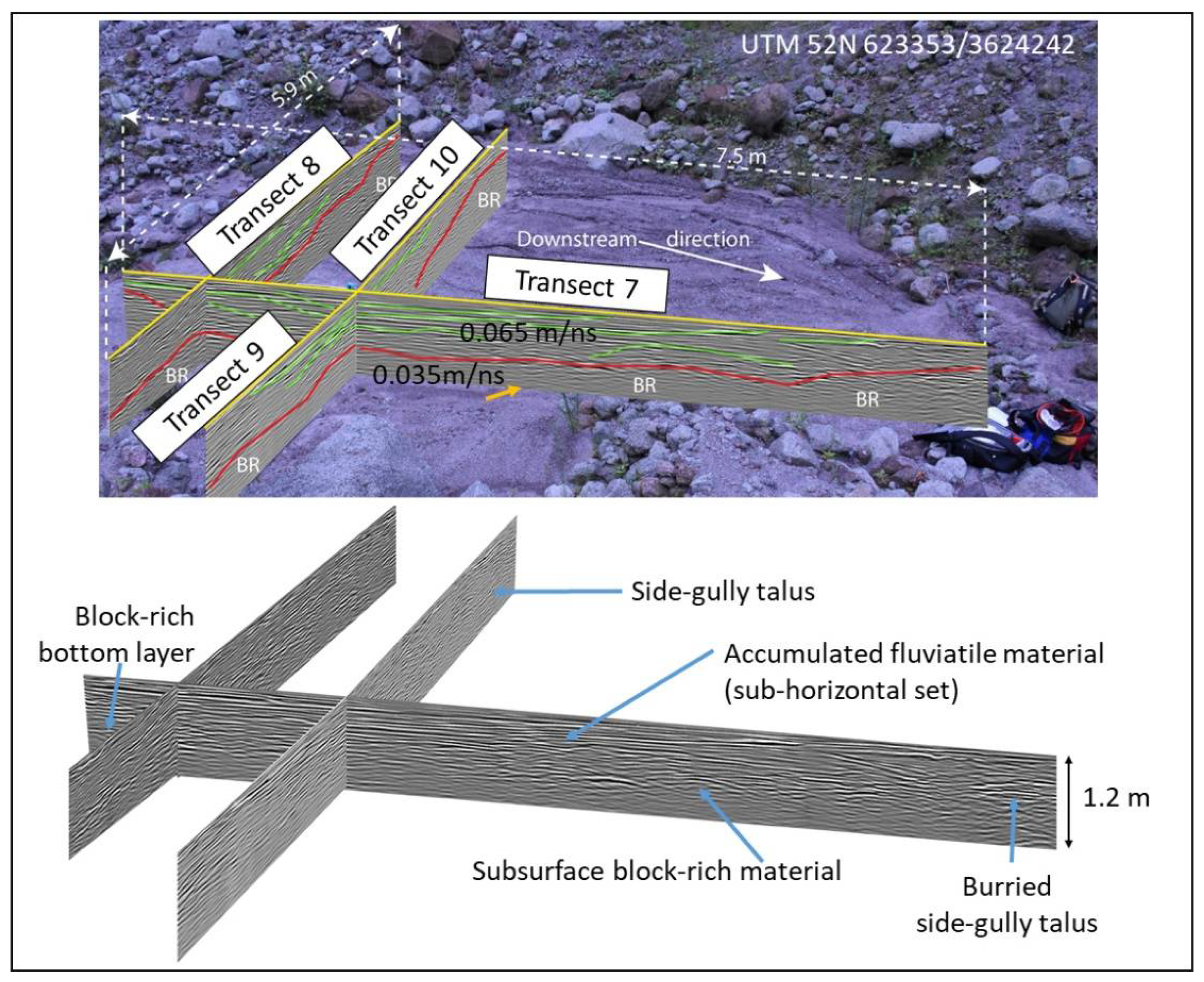
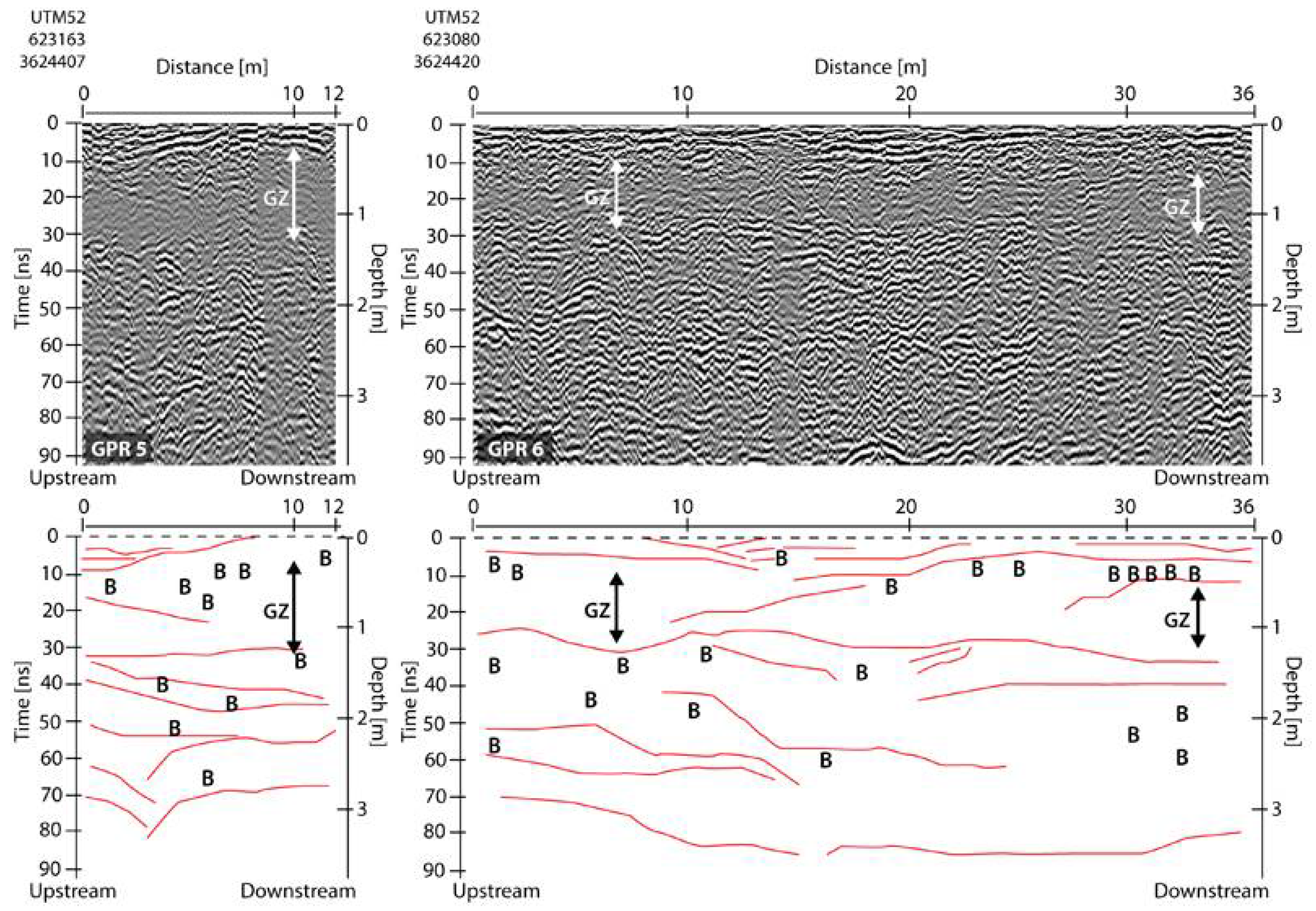
Publisher’s Note: MDPI stays neutral with regard to jurisdictional claims in published maps and institutional affiliations. |
© 2021 by the authors. Licensee MDPI, Basel, Switzerland. This article is an open access article distributed under the terms and conditions of the Creative Commons Attribution (CC BY) license (https://creativecommons.org/licenses/by/4.0/).
Share and Cite
Gomez, C.; Shinohara, Y.; Tsunetaka, H.; Hotta, N.; Bradak, B.; Sakai, Y. Twenty-Five Years of Geomorphological Evolution in the Gokurakudani Gully (Unzen Volcano): Topography, Subsurface Geophysics and Sediment Analysis. Geosciences 2021, 11, 457. https://doi.org/10.3390/geosciences11110457
Gomez C, Shinohara Y, Tsunetaka H, Hotta N, Bradak B, Sakai Y. Twenty-Five Years of Geomorphological Evolution in the Gokurakudani Gully (Unzen Volcano): Topography, Subsurface Geophysics and Sediment Analysis. Geosciences. 2021; 11(11):457. https://doi.org/10.3390/geosciences11110457
Chicago/Turabian StyleGomez, Christopher, Yoshinori Shinohara, Haruka Tsunetaka, Norifumi Hotta, Balazs Bradak, and Yuichi Sakai. 2021. "Twenty-Five Years of Geomorphological Evolution in the Gokurakudani Gully (Unzen Volcano): Topography, Subsurface Geophysics and Sediment Analysis" Geosciences 11, no. 11: 457. https://doi.org/10.3390/geosciences11110457
APA StyleGomez, C., Shinohara, Y., Tsunetaka, H., Hotta, N., Bradak, B., & Sakai, Y. (2021). Twenty-Five Years of Geomorphological Evolution in the Gokurakudani Gully (Unzen Volcano): Topography, Subsurface Geophysics and Sediment Analysis. Geosciences, 11(11), 457. https://doi.org/10.3390/geosciences11110457






